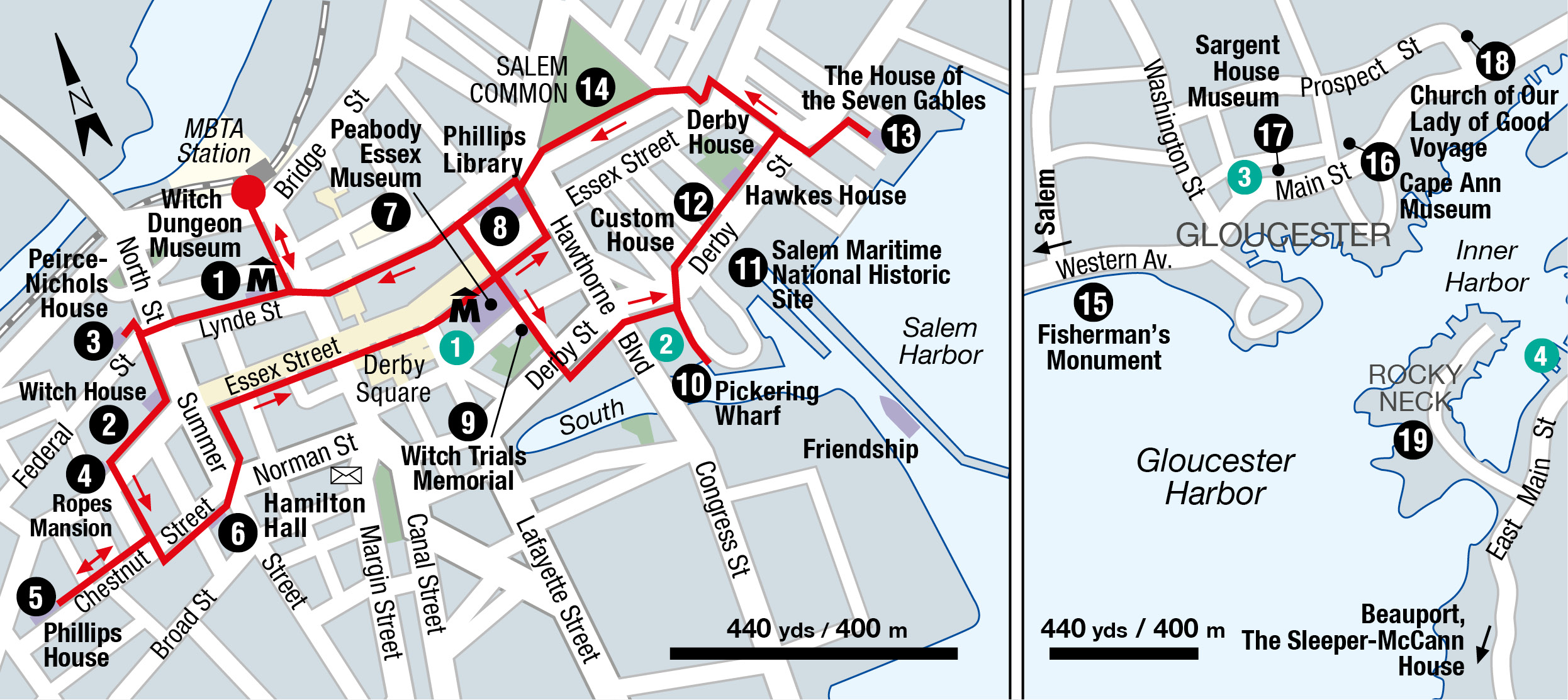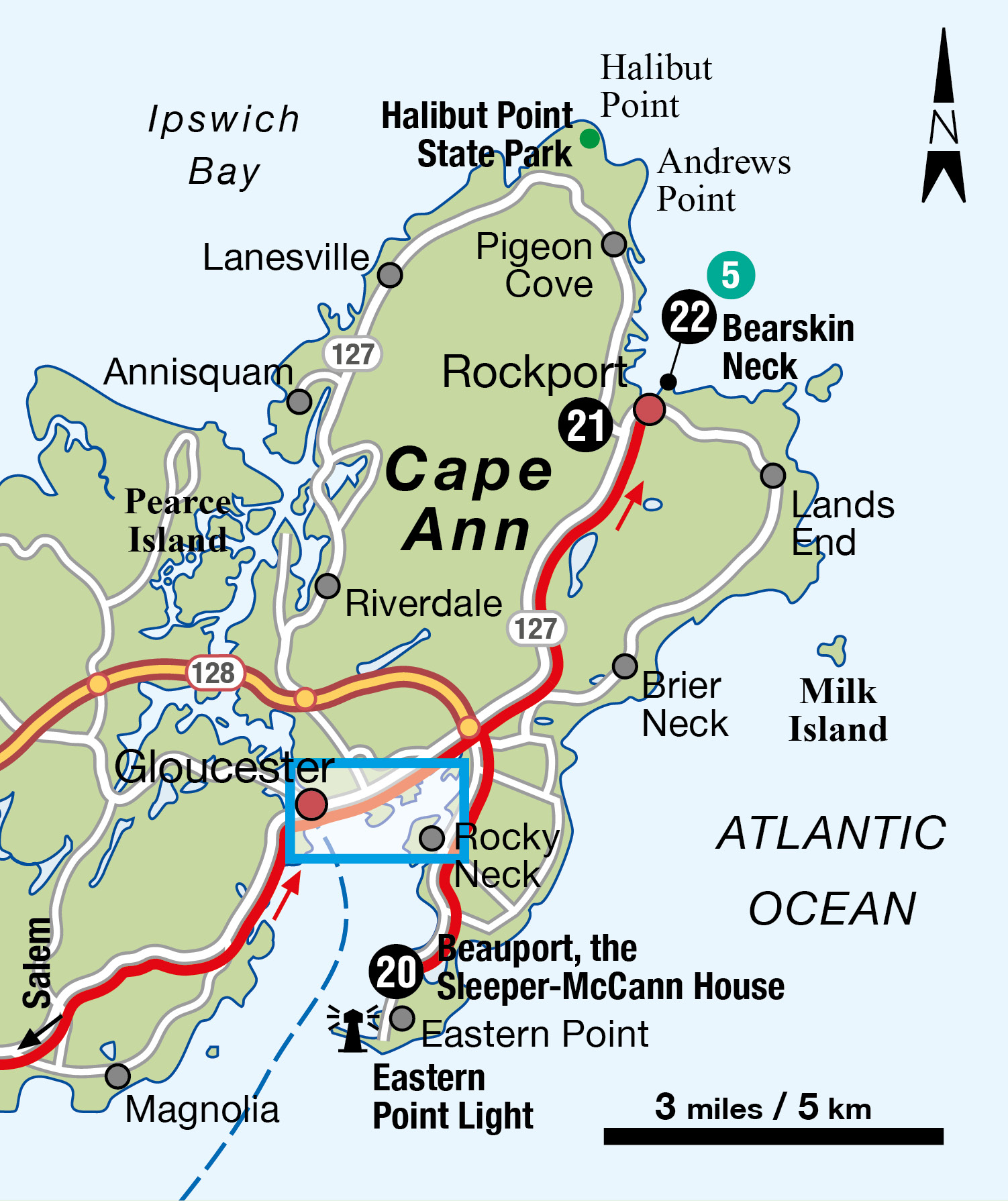DISTANCE: Salem to Rockport: 2.5 miles (38km); walking tour in Salem: 3.5 miles (5.5km)
TIME: Two days
START: Salem
END: Rockport
POINTS TO NOTE: Salem is 16 miles (26km) north of Boston. Driving is the best way of getting around Cape Ann; the scenic coastal route follows MA 127 beyond Salem. However, Salem, Gloucester, and Rockport can all be reached by train from Boston’s North Station (see www.mbta.com). There’s also a ferry that connects Salem and Boston from May to October (tel: 978-741-0220; www.salemferry.com; one way/round trip $25/45; 45 minutes), and you can get around on Cape Ann Transportation Authority buses (www.canntran.com).
Once one of the nation’s great seaports, Salem produced the country’s first millionaires, and has the architectural and cultural heritage to prove it in its McIntire Historic District and the protected properties of the Peabody Essex Museum. However, it does not take long to find reminders of the activities most often associated with the town – the trials and executions of ‘witches.’
The National Park Visitor Center (just off Essex Mall on New Liberty Street; tel: 978-740-1650; www.nps.gov; May–Oct daily 9am–5pm, Nov–Apr daily 10am–5pm) is the place to pick up maps and leaflets, consult the park rangers, and watch an excellent 27-minute film about the county’s history. You can also find useful information at www.salem.org.
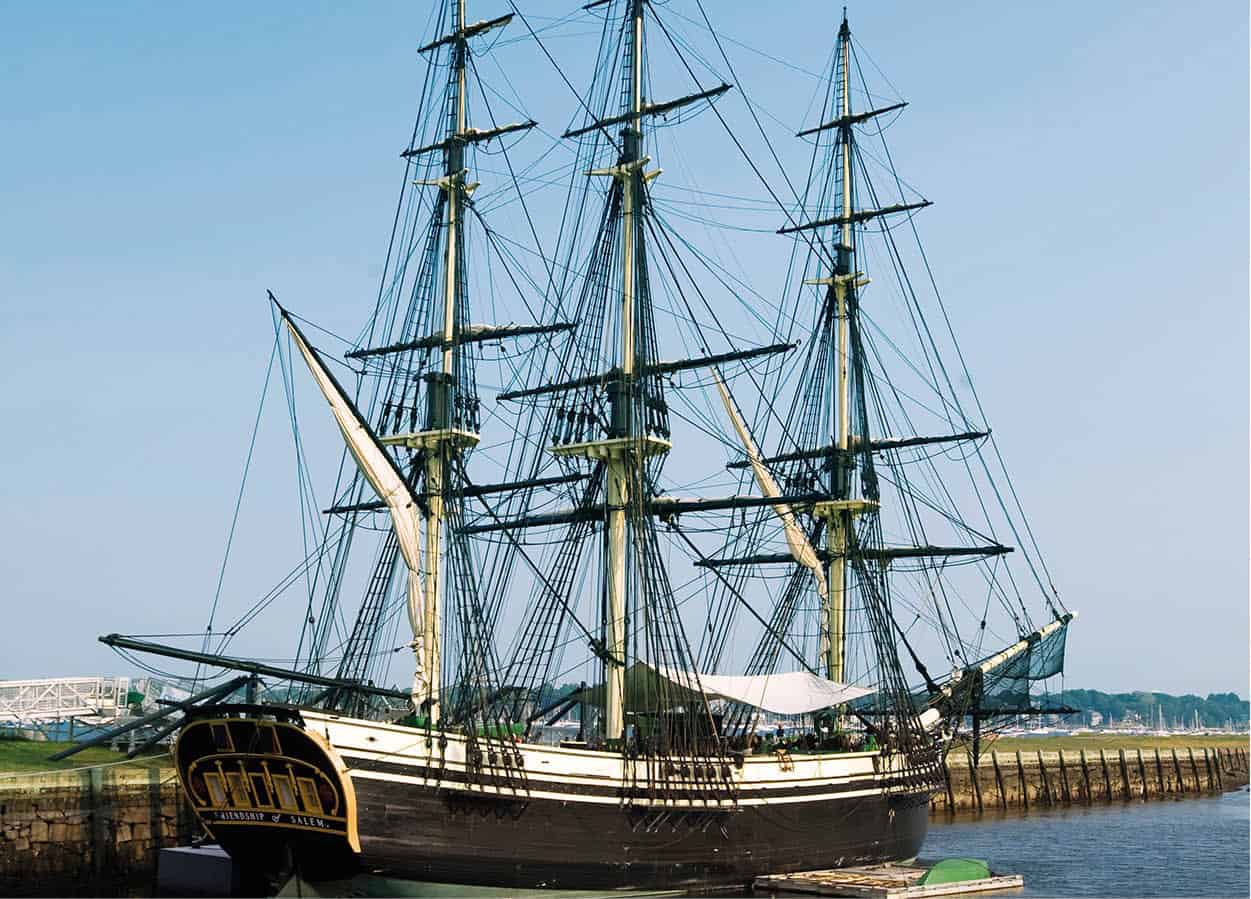
Replica of the Friendship at Derby Wharf
Nowitz Photography/Apa Publications
Witch Dungeon Museum
Park your car near Salem Station and walk down Washington Street, turning right onto Lynde Street after two blocks. At No. 16 is the Witch Dungeon Museum 1 [map] (tel: 978-741-3570; www.witchdungeon.com; daily 10am–5pm; charge), where you can watch a vividly staged reenactment of a trial, adapted from a 1692 manuscript, before being guided through the tiny dank dungeons in which the accused were held.
Salem’s witch hysteria
In 1692, between June and September, Salem fell under the dark spell of mass hysteria and executed 14 women and six men for witchcraft. You would be forgiven for thinking that the town is still obsessed with witches, for that sad history, portrayed in Arthur Miller’s play The Crucible, is recalled at many sites – a few historical, others mostly kitsch. Every October the town ramps up its black-arts connection even more to run a month-long celebration called Haunted Happenings (www.hauntedhappenings.org), culminating in the crowning of the king and queen of Halloween on the 31st.
Witch House
The spooky wooden house on the corner of Essex and North streets is the Witch House 2 [map] (tel: 978-744-8815; mid-May–Nov daily 10am–5pm; charge), where trial magistrate Jonathan Corwin cross-examined more than 200 suspected witches; the decor is authentic to the period.
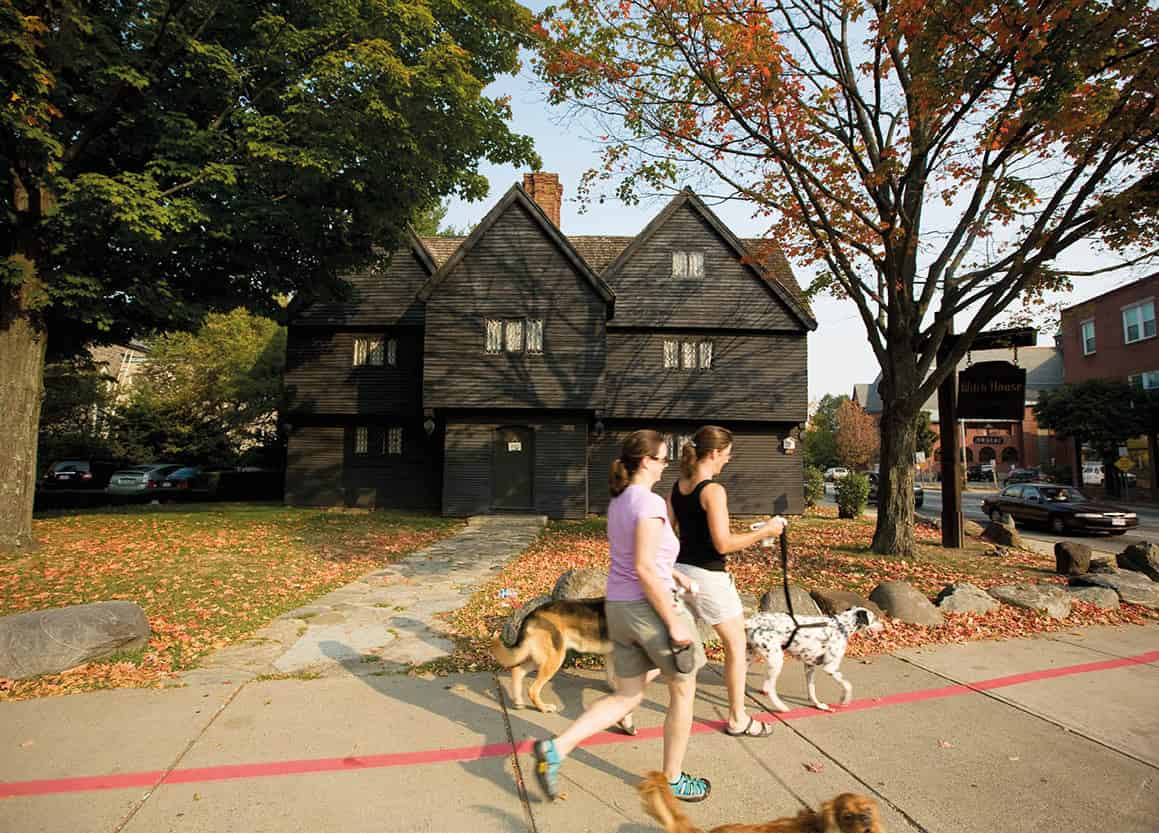
House of the Seven Gables
Nowitz Photography/Apa Publications
McIntire Historic District
Named for Samuel McIntire (1757–1811), one of the foremost American architects of his day, this historic area of Salem, roughly bounded by Federal, Flint, Broad, and Summer/North Streets, showcases four centuries of architectural styles.
Backtrack from the Witch House to Federal Street, where at No. 80 stands the McIntire-designed Peirce-Nichols House 3 [map] (c.1782); its east parlor has been restored and is open for tours by arrangement with the Peabody Essex Museum (for more information, click here).
Return to Essex Street and proceed to No. 318, the Georgian-period Ropes Mansion 4 [map], which stands in a beautiful garden and features a rare collection of Nanking porcelain and Irish glass.
Turn into quaint Botts Court and walk to Chestnut Street, one of Salem’s finest thoroughfares. At no. 34 is the fine Phillips House 5 [map] (tel: 978-744-0440; www.historicnewengland.org; June–Oct Tue–Sun 11am–4pm, Nov–May Sat–Sun 11am–4pm, tours every half-hour), where the carriage house contains several antique cars. Retrace your steps back along Chestnut Street, and continue to No. 9, the red-brick Federalist gem Hamilton Hall 6 [map] (tel: 978-744-0805; www.hamiltonhall.org; Mon–Fri 9am–noon; free).
From the corner of Chestnut Street, turn left onto Summer Street and then right at Essex Street to reach the pedestrian Essex Mall, recognizable by the red paving that matches the red bricks of the buildings. Turn right onto Central Street to find Red’s Sandwich Shop, see 1 [map].
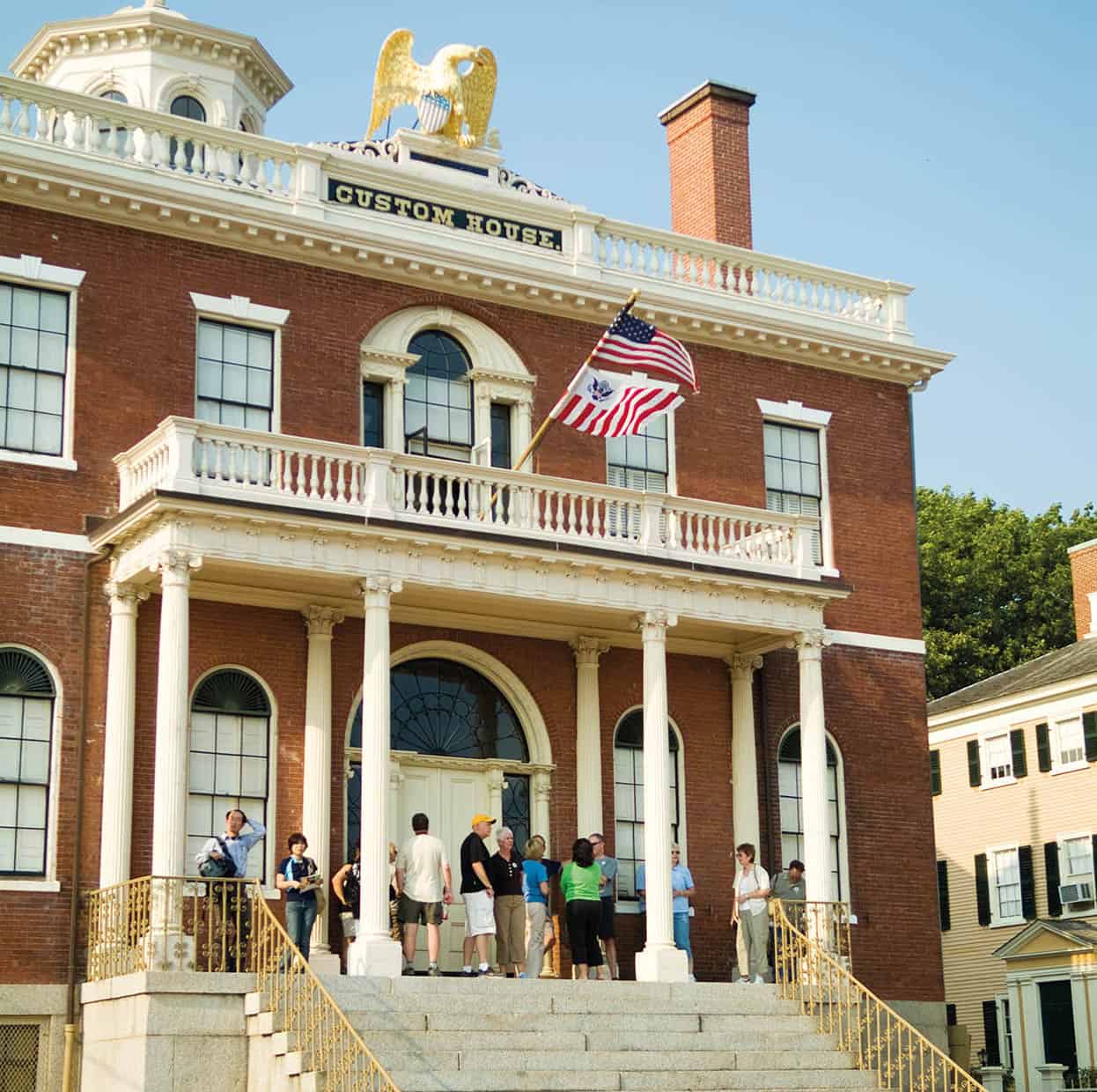
The Custom House
Nowitz Photography/Apa Publications
Peabody Essex Museum
Back on the mall, reserve a decent block of time to visit the outstanding Peabody Essex Museum 7 [map] (tel: 978-745-9500; http://pem.org; Tue–Sun 10am–5pm), where an impressive contemporary building by Moshe Safdie displays a fraction of the collection of nearly a million objects.
The museum’s origins date back to 1799 and to the art and antiques amassed by Salem’s seafaring merchants on their global travels. Ships’ models, figureheads, nautical instruments, charts and maps abound, but the museum also has fine antiques from China, Japan and India, as well as plenty of artifacts from the South Pacific (especially the Solomon Islands) and further afield. There’s also a 200-year-old Chinese merchant’s home, transported from China and rebuilt as part of the museum; entry to this is by timed ticket and advance reservations are advised.
Diagonally opposite the Peabody Essex Museum, a mini architectural park surrounds the red-brick Phillips Library 8 [map] (tel: 978-745-9500; http://pem.org; Wed–Thu 10am–4.30pm; free), which has a lovely reading room. Notice the stark contrast between the massive columns of the Andrew-Safford House (1819; 13 Washington Square) and, behind it, the tiny features of the Derby-Beebe Summerhouse (1799). Also here are the Gardner-Pingree House (1804; 128 Essex Street) and, from 1727, the neighboring Crowninshield-Bentley House.
On leaving the Peabody, follow the short footpath around its side until you reach Charter Street. Here, next to the Burying Point Cemetery – resting place of witch judge John Hathorne – is the most poignant of all Salem’s witch-connected sites. The Witch Trials Memorial 9 [map], dedicated by Holocaust survivor and renowned writer Elie Wiesel in 1992, is a contemplative space surrounded by 20 stone benches etched with the trial victims’ names, and shaded by a clump of black locust trees – reputedly the kind from which the convicted were hanged.
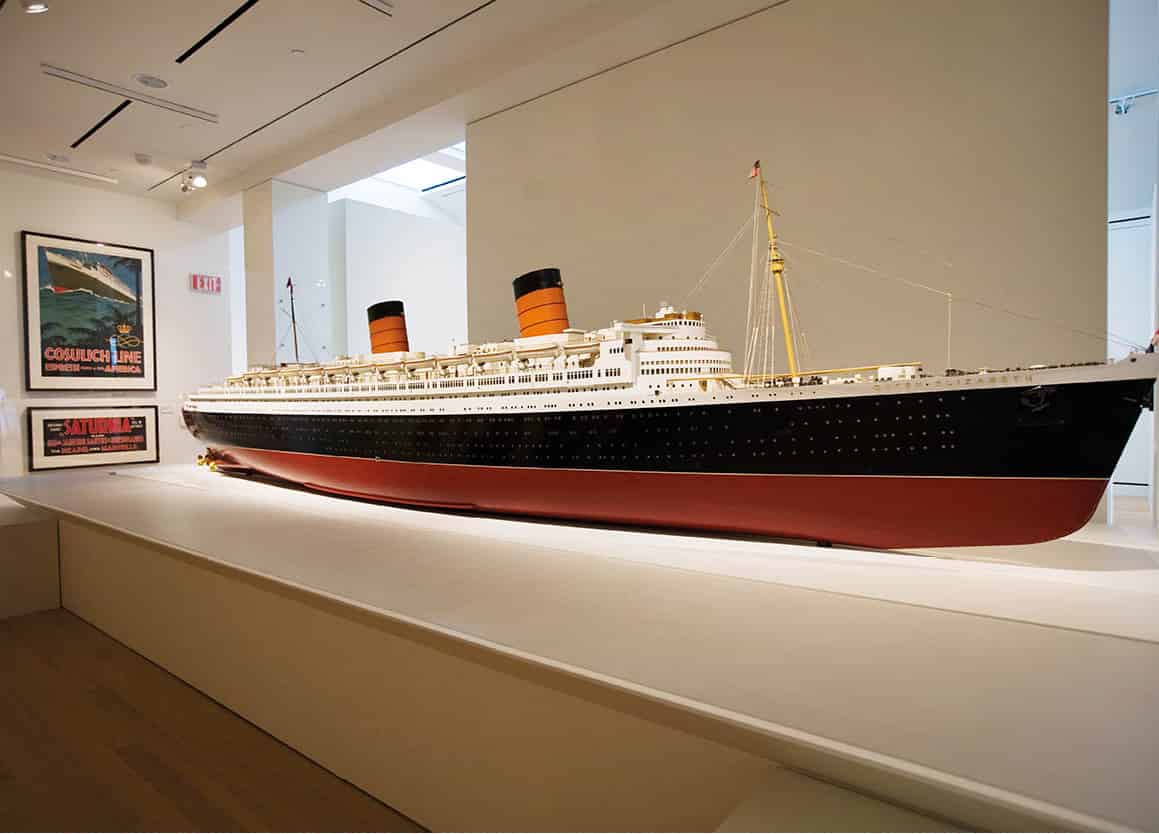
The Peabody Essex Museum displays all kinds of maritime artifacts
Nowitz Photography/Apa Publications
Salem Maritime National Historic Site
From the cemetery, cross Derby Street and walk along its south side toward Pickering Wharf ) [map], a touristy collection of stores, restaurants, and antiques shops. The best place to eat around here is Finz, see 2 [map].
Next to the wharf, the Salem Maritime National Historic Site ! [map] focuses on Salem’s port. Stop by the Orientation Center (tel: 978-740-1650; www.nps.gov; daily 9am–5pm) to find out about ranger-guided tours (charge) to the nearby Custom House, Derby House, and Narbonne House, as well as the Friendship of Salem, a full-scale replica of a 1797 three-masted East India merchant ship. It is docked at Derby Wharf, which is one of the few wharves that remain from the 40 of Salem’s heyday.
Custom House
Facing the wharf is the Custom House @ [map] (1819), surmounted by a gilded eagle clutching arrows and a shield in its claws, which was made famous by Nathaniel Hawthorne. Salem’s most famous son worked here for three years of ‘slavery,’ on which he based the introduction of The Scarlet Letter (1850).
Adjacent to the Custom House is the Hawkes House (1780; not open to the public) and, beyond that, the ochre-brick Derby House (1761). The former was built by shipowner Elias Hasket Derby (probably America’s first millionaire) to replace the latter, but it was never completed and was used as a storehouse for booty taken by his Revolutionary privateers.
The House of the Seven Gables
Continue down Derby Street from the Custom House to reach, at No. 115, The House of the Seven Gables £ [map] (tel: 978-744-0991; www.7gables.org; June Sun–Thu 10am–5pm Fri–Sat until 7pm, July–Oct daily 10am–7pm, Nov–Dec daily 10am–5pm, mid-Jan–mid-Feb Fri–Tue 10am–5pm,mid-Feb–May daily 10am–5pm), which inspired Hawthorne to write the 1851 novel of the same name. The small house in which he was born in 1806 has been moved into the grounds. Guides will lead you through rooms stuffed with period furniture. Take a breather in the lovely garden afterwards.
Return to the town center by walking via Salem Common $ [map], where you will find the historic Hawthorne Hotel (for more information, click here), an ideal base for the night.
Gloucester
Take the coastal route MA 127 northeast out of Salem and continue on for 16 miles (26km) to Gloucester. Founded in 1623, it is the nation’s oldest seaport. Unlike Salem, its harbor is still fairly active (although not as busy as it used to be), with many fishermen now of Portuguese or Italian descent.
On the way into town, just over the drawbridge spanning the Annisquam Canal stands the Fisherman’s Monument % [map], depicting a helmsman gripping a wheel as he scans the horizon. Those familiar with the book and film The Perfect Storm, about an ill-fated Gloucester crew, will know that the poignancy of this memorial to those who have perished at sea is not merely a matter of ancient history.
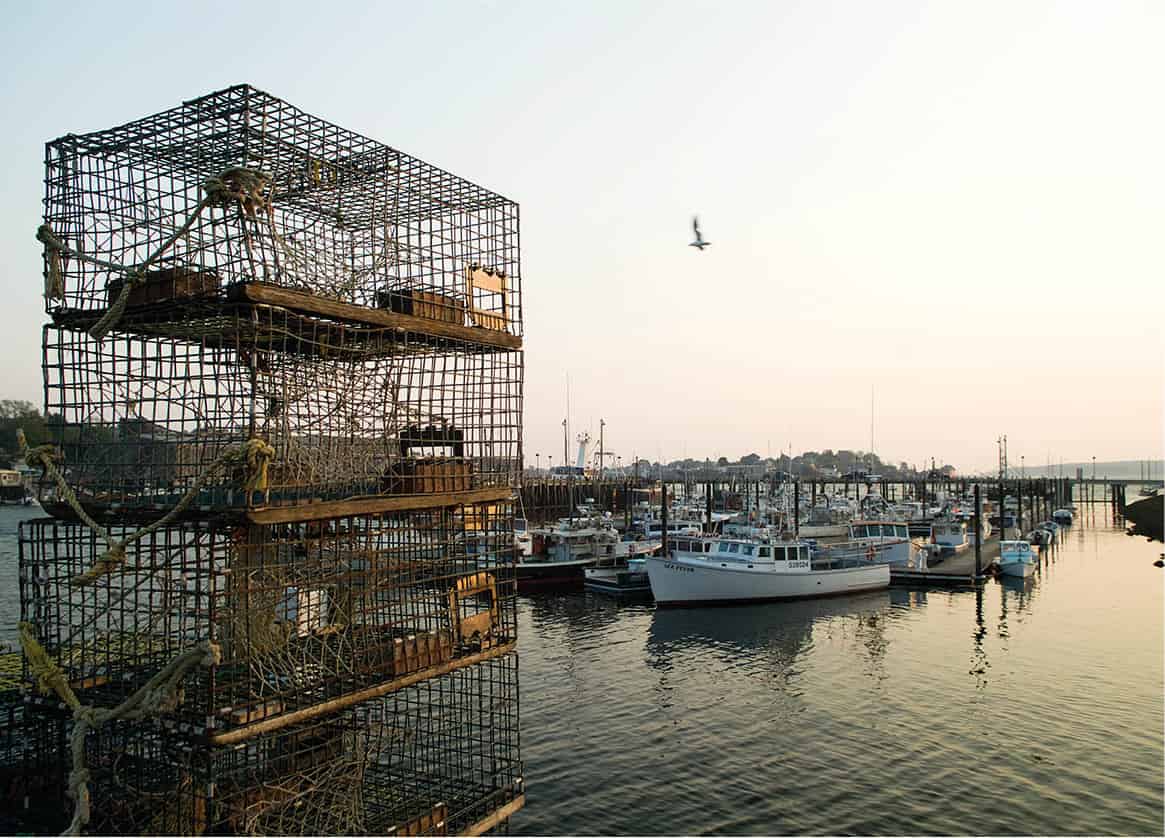
Gloucester harbor at dusk
Nowitz Photography/Apa Publications
Town Walk
Begin an exploration of the town at the Cape Ann Museum ^ [map] (27 Pleasant Street; tel: 978-283-0455; www.capeannmuseum.org; Tue–Sat 10am–5pm, Sun 1–4pm), displaying seascapes by the renowned American maritime painter Fitz Hugh Lane, and an interesting collection of furniture, silver, and porcelain, in the handsome home of Captain Elias Davis (1804) and the adjoining White-Ellery House (c.1709).
The Sargent House Museum & [map] (tel: 978-281-2432; http://sargenthouse.org; June–Aug Fri–Sun noon–last tour at 3pm) is a short walk west along Middle Street at No. 49. The home of Judith Sargent Murray, an early advocate of women’s rights, recreates the decor of 1782 when the house was built. A block south, toward the harbor, you will find several lunch options on Main Street, including Passports, see 3 [map].
Walk east on Main Street for 500m/yds and turn left on Prospect Street for the attractive Portuguese Church of Our Lady of Good Voyage * [map], recognizable by its two blue cupolas.
Rocky Neck and Eastern Point
Now drive around the harbor to East Main Street, passing Duckworth’s Bistrot, see 4 [map], and heading on to Rocky Neck ( [map] (www.rockyneckartcolony.org), the oldest artists’ colony in the US, in a wonderful coastal setting. Rudyard Kipling worked on Captains Courageous (1897), about Gloucester fishermen, while staying here.
On leaving Rocky Neck, turn right onto Eastern Point Road. After about 1 mile (1.5km), take the right fork, even though it’s marked ‘private.’ This is the exclusive enclave of Eastern Point, which has a score of magnificent homes. Open to the public is Beauport, the Sleeper-McCann House , [map] (tel: 978-283-0800; www.historicnewengland.org; June–mid-Oct Tue–Sat 10am–last tour at 4pm), which as built and furnished between 1907 and 1934 by Henry Davis Sleeper, a collector of American art and antiquities. On the tour you can see rooms he decorated to cover different periods of American life.
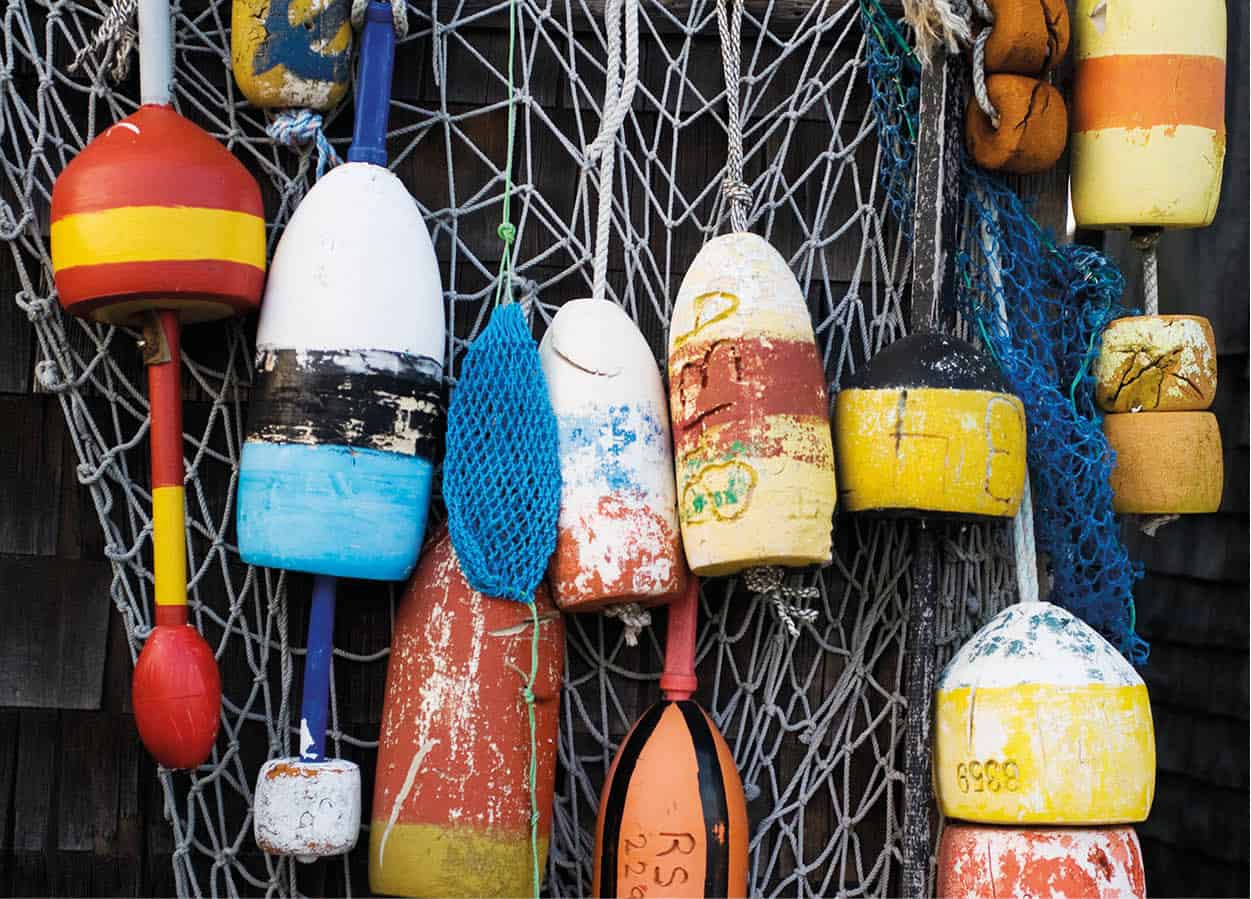
Colourful fishing floats
Nowitz Photography/Apa Publications
Rockport
About 7 miles (11km) northeast of Gloucester is picturesque Rockport ⁄ [map], once a shipping center for locally cut granite. In the 1920s Rockport was discovered by artists and remains an art colony today. A dozen or so galleries display works of both local and international artists on Main Street, but what attracts most tourists is Bearskin Neck ¤ [map]. This narrow peninsula, jutting out beyond the harbor, is densely packed with tiny dwellings and old fishing sheds, now converted into galleries, antiques stores, and restaurants.
Enjoy magnificent views of the Atlantic from the breakwater at the end of the Neck, just before which you will pass My Place by the Sea, see 5 [map].
Food and drink
1 Red’s Sandwich Shop
15 Central Street; tel: 978-745-3527; www.redssandwichshop.com; Mon–Sat 5am–3pm, Sun 6am–1pm; $
A Salem breakfast institution housed in the old London Coffee House, dating from 1698. Arrive early if you don’t want to stand in line.
2 Finz
76 Wharf Street; tel: 978-744-8485; ww.hipfinz.com; daily 11.30am–10pm Fri–Sat until 11pm; $–$$
The best place to enjoy seafood overlooking Salem Harbor. Bypass the lobster roll in favor of the excellent salmon wrap or great-value haddock sandwich.
3 Passports
110 Main Street, Gloucester; tel: 978-281-3680; http://passportsgloucester.com; Mon–Fri 11.30am–9pm, Sat–Sun 10am–9pm; $
Ideal for lunch or a quick snack, this romantically themed café has local artwork covering the walls and does great salads, soups, and seafood.
4 Duckworth’s Bistrot
197 East Main Street, Gloucester; tel: 978-282-4426; www.duckworthsbistrot.com; Tue–Thu 5–9.30pm, Fri–Sat 4–9.30pm; $$
A great place to return for dinner after a day’s outing around Cape Ann. Chef Ken Duckworth’s modern American cuisine uses the best of local produce. Many dishes, such as grilled organic chicken and sautéed veal cutlets, also come in half-portions.
5 My Place by the Sea
68 Bearskin Neck, Rockport; tel: 978-546-9667; www.myplacebythesea.com; daily 11.30am–9pm; $$
Fantastic views are guaranteed at this friendly place that serves imaginative modern American cuisine. It is good value for lunch, but pricier for dinner, when reservations are advised.
